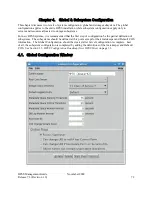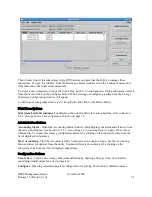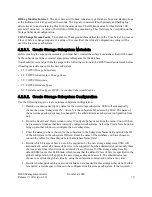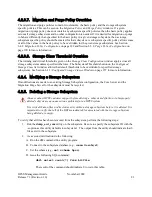
Chapter 5. HPSS Servers
Most HPSS Server administration is performed from the SSM graphical user interface
Servers
list
window
.
Each HPSS server has an entry in this list.
5.1. Server List
This window facilitates management of the configured HPSS servers. From this window, an HPSS server
can be started, shut down, halted, reinitialized, and notified of repair. Once a server is up and running,
SSM monitors and reports the server state and status. Information on running servers may also be viewed
and updated via this window.
If multiple entries are selected in the server list when a server operation is invoked, the operation will be
applied to all selected servers (although some servers don't support all operations).
The server entries displayed on the window can be sorted by each column category. To sort the server
entries by status, for example, click on the Status column title. The actual display can vary greatly by the
setting of window preferences. The Column View menu item can be used to select which columns of the
table are visible, and Preferences can be used to further refine and filter which servers are visible.
Preferences can also be saved and automatically reloaded by SSM when new sessions are started (see
Section 3.10:
SSM List Preferences
on page 69 for more information).
At times, the server list may update quite frequently with new Status or Opstate information. If you select
either of these columns for sorting, servers are likely to change their positions in the list rapidly.
Sometimes this makes the list hard to use, in which case you should consider selecting a more static
column for sorting or check the
Freeze
button to keep the list from updating.
Field Descriptions
Server List
.
This is the main portion of the window which displays various information about each server.
ID
. A unique numerical value assigned by SSM when each server starts. This value can change
each time SSM is restarted. In the default preferences, this column is not shown.
Status
. The server execution and connection status as determined by SSM. The reported status
will be one of the following:
•
Connected - Server is up and running and communicating normally with SSM.
•
Up/Unconnected - Server is up and running (according to the Startup Daemon) but SSM
cannot connect to it. Server cannot be completely controlled and monitored through SSM.
•
Down - Server is down. SSM can be used to start the server.
•
Indeterminate - The server’s state cannot be determined by SSM and the Startup Daemon
is either not running or not connected to SSM.
•
Check Config - SSM detected an incomplete or inconsistent configuration for the server.
HPSS Management Guide
November 2009
Release 7.3 (Revision 1.0)
83
Summary of Contents for RELEASE 7.3
Page 14: ...HPSS Management Guide November 2009 Release 7 3 Revision 1 0 14...
Page 195: ...HPSS Management Guide November 2009 Release 7 3 Revision 1 0 195...
Page 210: ...HPSS Management Guide November 2009 Release 7 3 Revision 1 0 210...
Page 215: ...HPSS Management Guide November 2009 Release 7 3 Revision 1 0 215...
Page 222: ...HPSS Management Guide November 2009 Release 7 3 Revision 1 0 222...
Page 266: ...HPSS Management Guide November 2009 Release 7 3 Revision 1 0 266...
Page 293: ...HPSS Management Guide November 2009 Release 7 3 Revision 1 0 293...
Page 367: ...HPSS Management Guide November 2009 Release 7 3 Revision 1 0 367...
Page 372: ...HPSS Management Guide November 2009 Release 7 3 Revision 1 0 372...
Page 384: ...HPSS Management Guide November 2009 Release 7 3 Revision 1 0 384...
Page 388: ...HPSS Management Guide November 2009 Release 7 3 Revision 1 0 388...
















































